What Is Dog Training?
Sit!… Down!… Roll!… Paw!…
Dog training is the process of teaching your dog certain behaviors. It can be as simple as commands like “sit,” “down,” or “here. It can also be more complex and involve behavior modification, such as when your dog is afraid of certain situations or is too aggressive.
The goal of dog training is to have a healthy, happy, and well-behaved dog. It helps improve communication between you and your dog. It strengthens your bond and makes your life together easier and more enjoyable.
Positive reinforcement is often used in dog training. This means that your dog is rewarded for doing something right. The reward can be a treat, praise, or a game.
There are different types of dog training, such as obedience training, agility training, canine sports, service dog training, and more. Each training should be tailored to the individual needs and abilities of the dog.
Finally, it is important to know that dog training is not a one-time event. It is an ongoing process that requires consistency, patience, and understanding. It’s a great way to spend time with your dog and get to know him better.
Why Dog Training Is Important
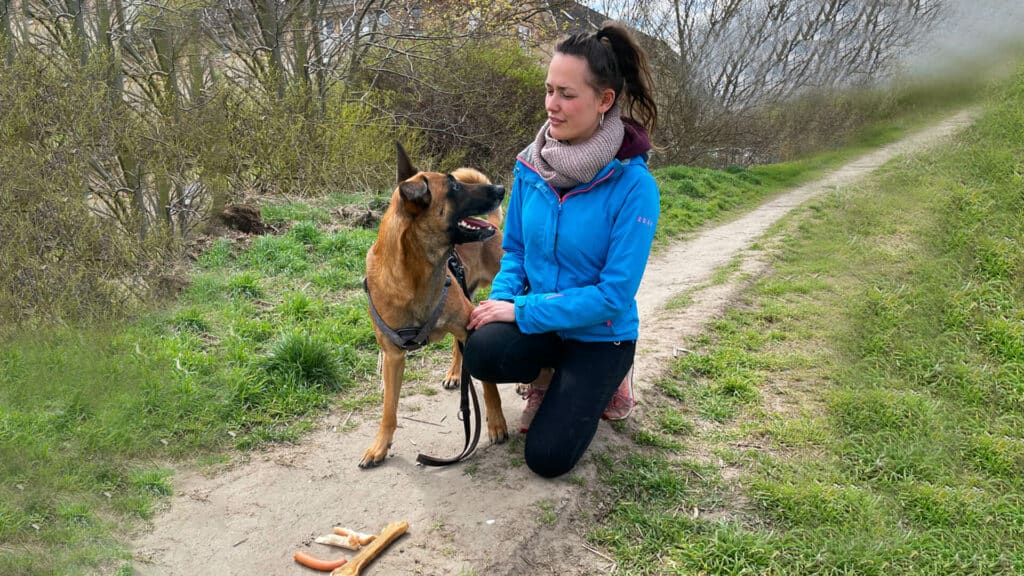
There are so many tricks you can learn with your dog. And the best part is that you will both have a lot of fun doing them.
There are many things you can train your pet to do. Some of the most important skills are obedience and impulse control. But practicing tricks can also be fun for both of you.
There are many reasons why dog training makes sense. For one, your dog will listen to you better.
After training, he will stop pulling on the leash, listen to your commands, and may even obey commands such as “sit”, “down”, and “give paw”. Second, it strengthens your bond and the trust between you.
Dog training should be fun for both of you. Your pet gets exercise, is kept busy, and you get to spend time together.
And the good side effect:Your four-legged friend has been trained to react correctly in difficult situations.
When Can I Start Training My Dog?
You can start dog training as soon as your dog comes home to you, which is usually around 8 to 12 weeks old for puppies. At this early age, they are particularly receptive and curious, which makes learning easier.
Start with simple commands like “sit”, “down”, or “stay”. Positive reinforcement is very important. Always reward your dog when he does something right, such as with a treat or praise.
Remember, however, that puppies have short attention spans. Keep training sessions short and fun. Several short training sessions throughout the day are better than one long session.
And please keep in mind that patience is key. Every dog is different, and some learn more quickly than others. Always be friendly and patient with your dog during training. It should be a positive experience for both of you.
Once your dog has mastered basic commands and is old enough, you can begin advanced training such as obedience or agility. The most important thing is that you and your dog enjoy the training!
To make sure that your practice works perfectly, I’ll give you some important tips and tricks here. At the end you will find some exercises that can complement your training:
10 Things to Keep In Mind When Exercising
#1. Start Training at Puppy Age
It is important to give the dog basic training from the beginning. Obedience is especially important. The younger your dog is, the more he can learn.
He has more energy and a greater need to move. That’s why training young dogs is twice as much fun.
But don’t be discouraged if your furry friend is already fully grown. Even older animals can be taught a lot.
#2. Be Consistent but Not Rigid
Always remember: During training, you are the leader of the pack. You give the commands and decide which exercises will be done.
If you are not firm enough during the exercises, your dog may not respond at all. In any case, you must not appear indecisive.
Still, a friendly tone is important. After all, you want to build trust with your dog. And he should enjoy the training.
#3. Different Tone of Voice for Commands Than in Everyday Life
If you give the commands in the same voice you always use, your dog will probably not respond. Dogs do not understand our language.
It does not matter what words we use. Our faithful companions can tell what commands we give them by the tone of our voice and the melody.
Therefore, the words should be short and precise. But make sure that the tone is not too stern.
#4. Hand Signals Support What Is Being Said
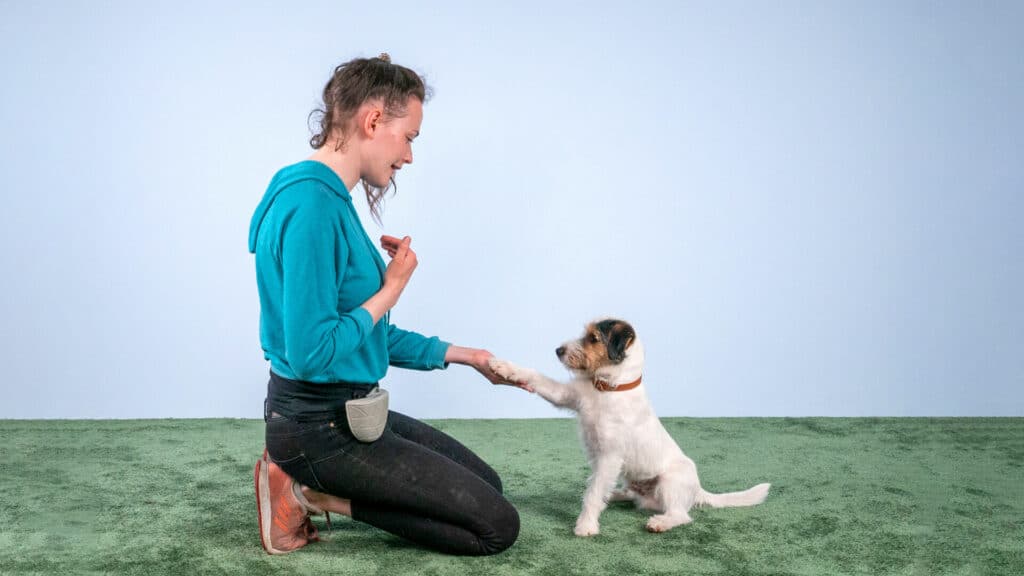
Since dogs do not understand our language, they can better understand the commands through gestures.
Then it usually works without words. In addition, the combination of voice and hand signals increases the learning factor: Your four-legged friend learns commands much faster.
#5. Repeat His Name
Saying your pet’s name over and over again during training will help them remember it.
In time, he will understand who is meant. After a while, he will respond to his name. This builds trust.
#6. Much Praise
How is your dog supposed to know he did something right if you don’t show him? He will appreciate any attention he gets from you.
You are his reference point during training. Therefore, it is especially motivating for your pet when you make him happy. Confirmation in the form of praise is therefore important for training success.
Don’t forget to praise him after training.
#7. Reward With Treats
This small reward is especially important at the beginning of training. When your protégé gets a treat after doing an exercise well, he will associate it with something positive and will do it more often from then on.
After all, he has the hope of getting a reward every time. So you have his full attention during the training.
Of course, you can’t give him a treat for every good deed later on. However, you should reward him from time to time after training.
What Treats Are Appropriate for Training?
Small, soft treats are best for dog training. They should be easy to chew and swallow so that training is not interrupted. Here are some tips:
- Size: Treats should be small enough for your dog to eat quickly. They should not be so large that your dog has to chew for a long time to eat them.
- Taste: Choose treats that your dog really enjoys. This may vary from dog to dog. Some like meat, others like cheese or fish. Try different types to find out what your dog likes best.
- Quality: Look at the list of ingredients. Treats should be healthy and contain no harmful additives. Treats made from natural ingredients are best.
- Variety: Don’t use the same treats all the time. Change them up from time to time to keep your dog interested.
- Reward: Use treats only as a reward during training. Do not give them just out of the blue, or they will lose their motivational effect.
And don’t forget that treats contain calories. If you give your dog a lot of treats, adjust his overall food ration accordingly to avoid obesity.
What Are Super Treats?
Super Treats are special treats that you give your dog to reward him for outstanding performance or behavior. They are often tastier and more appealing to your dog than regular treats.
The idea is that these Super Treats are given infrequently and are something special that will motivate your dog. They can be small pieces of chicken, cheese, or sausage, depending on what your dog loves.
However, it is important that you eat a healthy diet even when you are enjoying your treats. They should not contain harmful additives or too much fat or sugar.
Although super treats can be very effective, they should be used sparingly. They are a reward, not a main food. And like all treats, they should always be given as part of a balanced diet and should not contribute to obesity.
#8. Keep in Order
It is not a good idea to vary an exercise from time to time. This will only confuse your dog. He will not know exactly what to do and will not learn as quickly.
Choose a fixed sequence that you repeat each time. For example, give the hand signal command first.
When your dog completes the exercise, praise him and give him a treat.
You should praise him immediately after he does it and not wait. Otherwise, he will not connect the two actions.
It is also helpful to give the hand signal and the word at the same time. This way your dog can clearly associate the command.
#9. Avoid Distractions
Training is much more effective if your furry friend is not distracted. Cars, other dogs or noises are much more interesting than training. But the exercises require your dog’s full attention.
It’s best to choose a secluded area such as a meadow or dirt road for dog training.
When your dog can do everything well, slowly get him used to distraction. After all, he should be able to use the exercises on the road.
#10. Not Too Long at a Time
Especially with young dogs, it is important not to overwork them. Instead, train him in short bursts, but more frequently. Otherwise, his attention will wane and he will lose interest and enjoyment in the exercise.
The infographic shows different types of rewards that can help your dog in training.
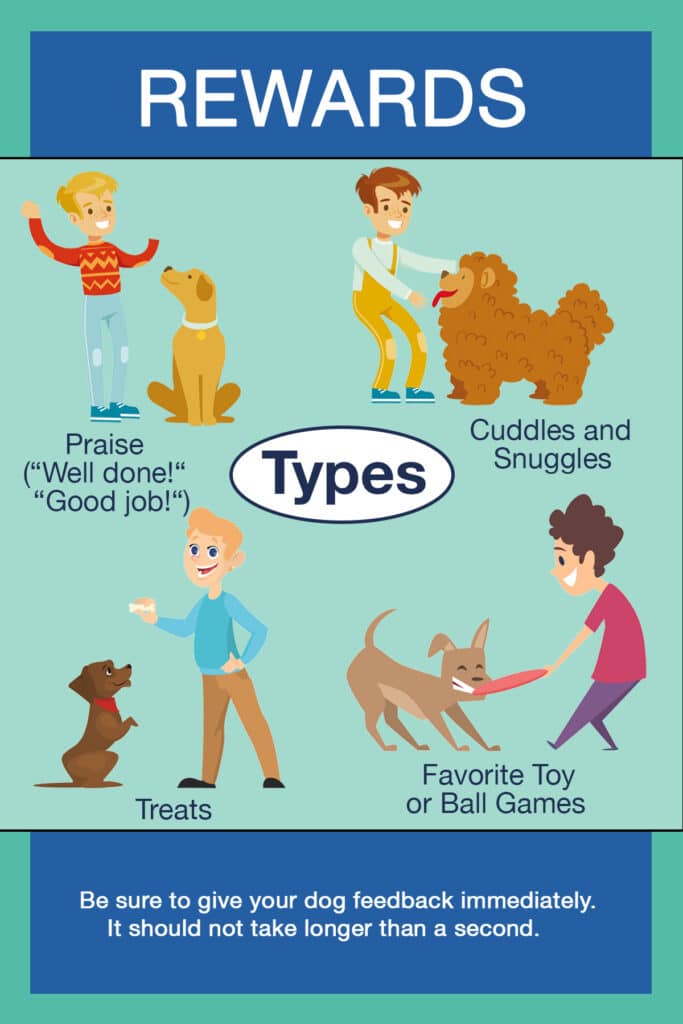
Tips for Exercises: Follow These While Teaching!
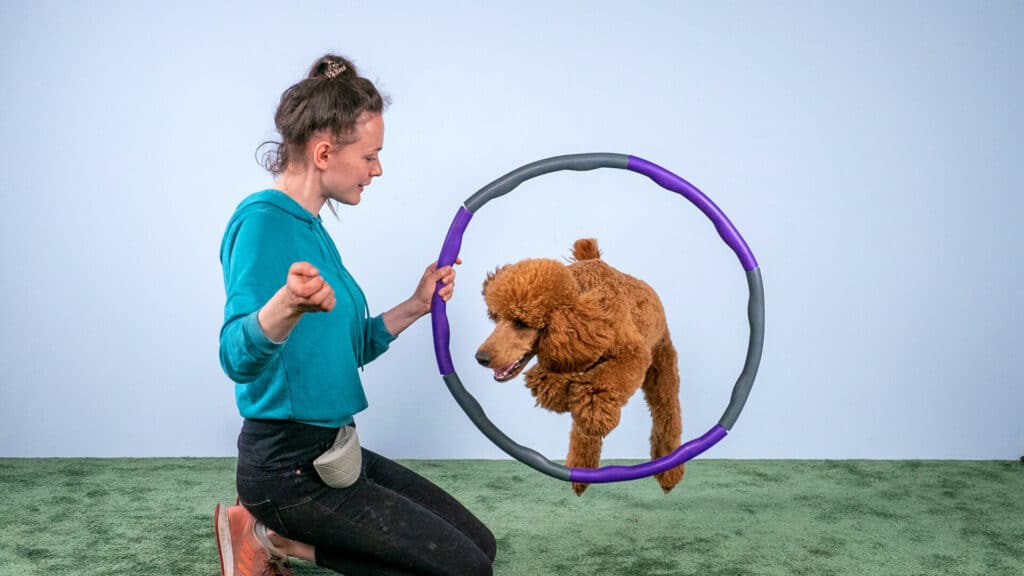
Now you know exactly what to look for in dog training. But what exercises can you do and how do you do them?
There are many different ways to train your dog or teach him tricks. Below are a few that are easy to do, even for beginners.
1. Dog Stays Close Without Leash
You should always keep your dog on a leash near roads and people. Otherwise, the risk of something happening is too great.
But if you are on a lonely dirt road, your dog will want to explore on his own. This only works if he listens to your commands and does not stray too far from you.
This exercise is easiest with puppies. Older dogs often already have habits that are difficult to break.
It is especially important to train in secluded areas. When people or other animals are around, the temptation to run after them is too great.
When you are sure that nothing will distract your dog, you can let him off the leash. You can then take a normal walk.
This is a new and exciting situation for your dog. And because he is so curious, he will either run much faster than you, or he will smell something interesting and stay behind.
Keep calling his name so that he will come back to you. If he still doesn’t come, just keep walking. Don’t stop to look for him.
Maybe you can even hide somewhere and then call his name. Your dog will immediately come looking for you. Alone, he feels insecure and desperately wants to be near you again.
When he has found you, he is even more pleased. Praise him for it. He will remember this experience and will not run so far away next time.
2) Teaching the “Stay!” Command
The prerequisite for this exercise is that your dog already responds to the commands “sit” and “down. Most dogs will learn these commands quickly..
Walk your dog a few feet and then stop. Give him the command “Sit” first.
Alternatively, the command “sit” will work. If he does this for a few seconds, reward him.
On the next try, give him the command “Stay”. At the same time, extend your flat hand in front of you.
Gently take a few steps back and repeat the command. If your dog remains seated and does not immediately jump up, be sure to reward him.
At first, your dog may not listen to this command. It will not understand why it should do this.
After all, he wants to be with you. But if you practice it with him over and over again and reward him afterward, he will get used to it quickly.
Over time, you can increase the distances. It’s best to practice one step at a time and not go too far in the beginning.
After a while, your dog will sit quietly even when you are out of sight.
3) Jumping On People Is a No-Go
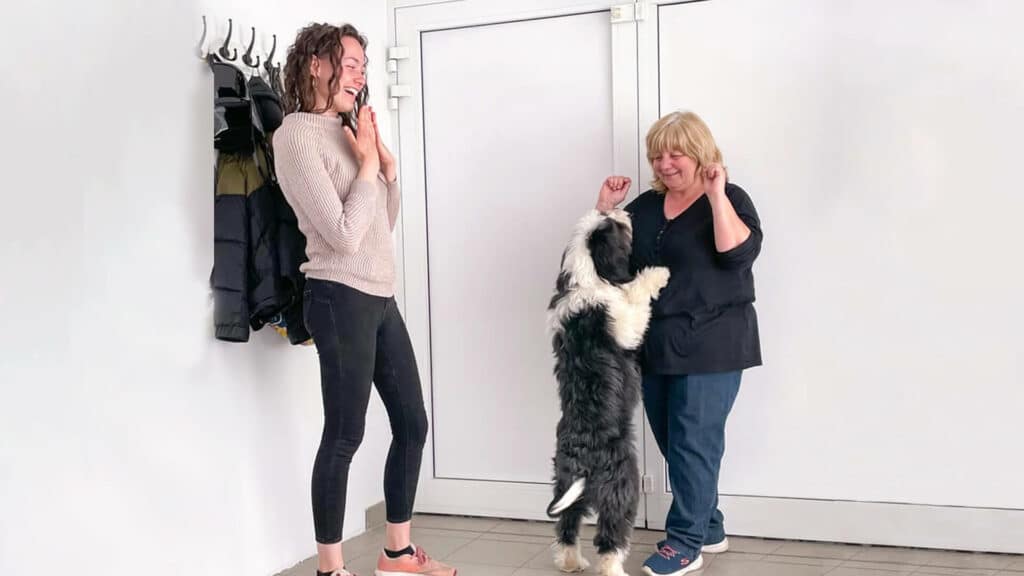
What is not a problem with small dogs is quite different with a Great Dane or a Boxer.
Your visitor is probably not thrilled to be jumped on by a 50 kg dog. Besides, it is a form of obedience if your dog does not jump on people.
Especially young dogs who are full of energy like to jump up. If you meet your puppy in a squatting position from the beginning, he won’t need to jump up at all.
If he still tries, gently push him away. If that doesn’t work, walk away. This will show him that his behavior was wrong.
With older or larger dogs, if he jumps at you, move to the side. That way he will jump into the void.
Always turn away or ignore him. If he jumps on your visitors or strangers on the street, put him on a leash for safety.
Over time, your pet will realize that jumping on him is useless. He has a bad experience with it because he is ignored. After a while, he will stop doing it completely.
4) Teach Your Dog to Return Toys
This exercise takes more time than the previous one. But it will be even more fun for your dog.
The difficulty with retrieving is that your dog must not see the object as a toy. His job is to bring it back to you and to give it back to you.
You’ve probably seen your dog retrieve a toy you threw, but not let go of it or even run away. This is not the purpose of retrieving.
Suitable objects include wood, toys, or the food bag. The latter, of course, is a special incentive.
In the beginning you should place the objects at some distance. Later you can throw them. Then ask your dog to retrieve the item.
If he doesn’t know what you mean yet, you can go to the object with him and show him. Practice this until he has no more problems.
It’s best to practice retrieving indoors and then outdoors. If your dog is already a pro, you can also hide the objects. This is especially fun for him.
5. Train Release Signal
An important element in dog training that most people do not know about. When you give a command such as “sit,” “down,” or “stay,” your dog should obey that command.
But then what? If you don’t release the command after that, it will eventually stop sitting or staying in place on its own. Therefore, you should release every command after a certain amount of time. The best way to do this is with a word like “OK. It is important that your dog learns that you are giving a command and that you also determine when it is over.
So follow this tip and it will make your dog’s daily life much easier.
Too theoretical for you? If you prefer a visual approach, our app offers step-by-step video instructions to help you train your dog.Learn more about our app here.
Dog Training Accessories
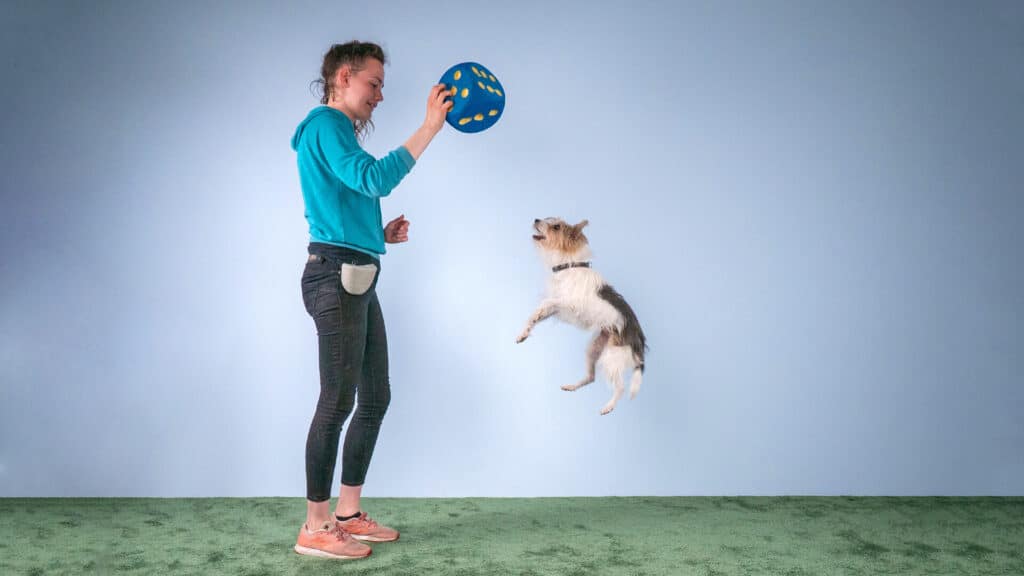
To train a dog, you need some basic things that will help you and your dog make the training effective and enjoyable:
- Leash and Collar or Harness: They are important for safely guiding and controlling your dog during training.
- Treats: They are an important tool to reward good behavior and motivate your dog.
- Toys: Toys can also be used as rewards or motivation, especially if your dog is very playful.
- Clicker: A clicker can be used to mark a specific behavior at the right time and then reward it.
- Exercise Mat or Blanket: A mat or blanket may be helpful to show your dog a specific place to sit or lie during training.
- Treat Bag: A treat bag is a useful tool in dog training. It is often attached to a belt or waistband and is used to store treats for the dog during training.
- Water and Water Bowl: During extended training sessions, it is important that your dog has access to fresh water.
- Patience and a Positive Attitude: Although they are not physical tools, patience and a positive attitude are perhaps the most important “tools” for successful dog training.
Remember that any training should be tailored to your dog’s individual needs and abilities. What works for one dog may not work for another. It may take some experimentation to find what works best for your dog.
Cost of Dog Training
The cost of dog training can vary greatly depending on many factors such as the type of training, the location, the experience of the trainer, and the length of the course.
A group course at a dog school can cost around 100 to 200 Euros for a course lasting several weeks. Individual lessons with a professional dog trainer can cost between 50 and 100 Euros per hour, sometimes more, depending on the trainer and the specific training.
Online courses, apps or books about dog training are often cheaper and can be a good alternative if you want to work on your own. They can cost anywhere from 20 to 100 Euros.
There are also free resources, such as videos and articles on the internet, that can help you learn the basics of dog training.
Remember that cost is only one consideration. More important is that the trainer is qualified and uses a method that works for you and your dog. Good dog training is an investment in the future and can give you and your dog many years of enjoyment.



